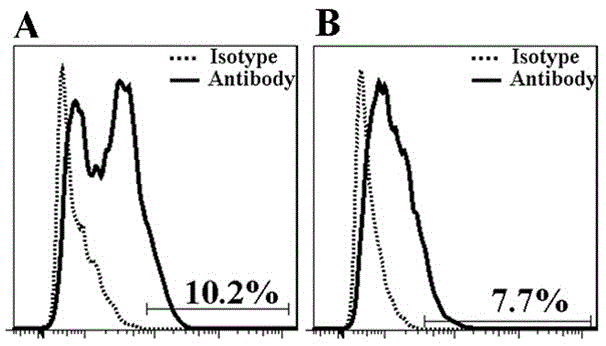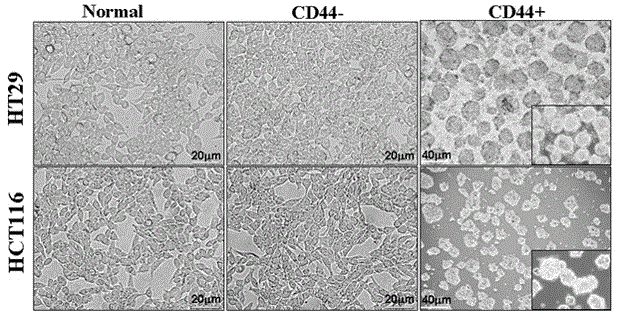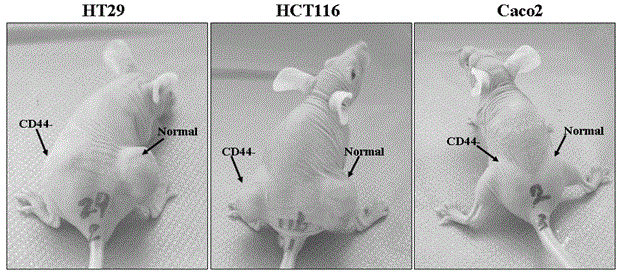Inhibition application of respiratory chain compound V in colorectal cancer stem cell treatment
A technology of colorectal cancer and compound, applied in the direction of drug combination, medical preparations containing active ingredients, organic active ingredients, etc., can solve the problems of inhibiting electron transfer, increasing electrochemical gradient, affecting the function of proton pump, etc.
- Summary
- Abstract
- Description
- Claims
- Application Information
AI Technical Summary
Problems solved by technology
Method used
Image
Examples
Embodiment 1
[0018] Example 1: Expression of tumor stem cell marker CD44 in colorectal cancer cells and isolation and culture of CD44 positive cells.
[0019] Both colorectal cancer cell lines HT29 and HCT116 in the present invention were purchased from the Cell Bank of Kunming Institute of Zoology, Chinese Academy of Sciences. Colorectal cancer cells HT29 and HCT116 in the present invention were prepared in DMEM (Gibco Company, Code No. 10566- 016) culture medium, in a 37°C incubator (ThermoScientific Company, CodeNo.370), CO 2 Cultured at a concentration of 5%.
[0020] The expression rate of tumor stem cell marker CD44 was detected by flow cytometry. Two colorectal cancer cell lines were digested into single cells by trypsin (Gibico Company, Code No. 25200-056), transferred to a 15ml centrifuge tube filled with phosphate buffer, centrifuged at 300g for 7 minutes to collect 2×10 5 Cells were resuspended in 160 microliters of phosphate buffered saline, and the cells were divided into t...
Embodiment 2
[0023] Example 2: Differences in mitochondrial morphology and function between colorectal cancer stem cells (CD44 positive) and non-stem cells (CD44 negative).
[0024] The cultured colorectal cancer stem cells HT29 / CD44+, HCT116 / CD44+ and non-stem cells HT29 / CD44-, HCT116 / CD44- were fixed with glutaraldehyde, and the mitochondria were observed with a transmission electron microscope (assisted by the microscope observation laboratory of Kunming Medical University) The microstructure, take pictures of 10000 times and 50000 times, see Figure 4 indicated by the arrow. It was found that colorectal cancer stem cells HT29 and HCT116 had larger mitochondrial diameters than non-stem cells, and there was no significant boundary between mitochondrial inner cristae structures.
[0025] In addition, colorectal cancer stem cells HT29 / CD44+, HCT116 / CD44+ and non-stem cells HT29 were treated with mitochondrial inner membrane dyes Mito-TrackerGreen (ThermoScientific Company, Code No. / CD44...
Embodiment 3
[0028] Example 3: The effect of complex V inhibition on the proliferative activity of colorectal cancer stem cells (CD44 positive).
[0029] Colorectal cancer stem cells HT29 / CD44+, HCT116 / CD44+ and non-stem cells HT29 / CD44-, HCT116 / CD44- were seeded in 96-well cell culture plates at a density of 1000 cells / well, and three different concentrations (0.1 μg / ml, 0.5μg / ml, 1.0μg / ml) respiratory chain complex V inhibitor oligomycin A (TOCRIS company, CodeNo.4110) to treat the cells, and use the cell proliferation activity detection kit (Promega company, Code No.G3581) to detect cell activity on days 0, 2, 4, 6, and 8. Compared with cells not treated with uncoupling agent, the cell proliferation activity of colorectal cancer stem cells HT29 / CD44+ and HCT116 / CD44+ after treatment with oligomycin A was significantly inhibited on the second day, see Figure 8 As shown in A and C, the proliferative activity of non-stem cells HT29 / CD44- and HCT116 / CD44- showed a slight increase, see F...
PUM
| Property | Measurement | Unit |
|---|---|---|
| diameter | aaaaa | aaaaa |
Abstract
Description
Claims
Application Information
 Login to View More
Login to View More - R&D
- Intellectual Property
- Life Sciences
- Materials
- Tech Scout
- Unparalleled Data Quality
- Higher Quality Content
- 60% Fewer Hallucinations
Browse by: Latest US Patents, China's latest patents, Technical Efficacy Thesaurus, Application Domain, Technology Topic, Popular Technical Reports.
© 2025 PatSnap. All rights reserved.Legal|Privacy policy|Modern Slavery Act Transparency Statement|Sitemap|About US| Contact US: help@patsnap.com



